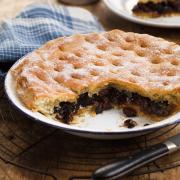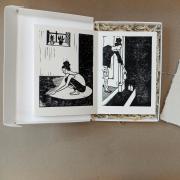Chef patron of one Michelin star The Old Stamp House and owner of Kysty, in Ambleside, Ryan Blackburn, suffers setbacks in his search for special ingredients – but his mushroom dish provides cheer
I spend a lot of my time searching, researching and then ultimately sourcing ingredients for my menus. It’s something I mention regularly in this column because it’s very important to me and also possibly one of the biggest challenges about being a chef.
When searching for ingredients there are several things I look for: uniqueness, quality and consistency. Then I’ll check further to see if it fits in with the ethos of what we do.
For example, I absolutely love eating red prawns from Denia in Spain, which for me have to be some of the best shellfish in the world, but I would never serve them at the restaurant. Even though they are excellent it goes without saying that they just wouldn’t belong in the Cumbrian led menu we serve. However, the lobsters and crab that we can source in the summer from our coast do.
Once we find an ingredient, we try it to make sure the quality is high enough and work out if we can find a place for it on the menu.
Then comes the real test, which is often the most frustrating one: can we get it consistently into the restaurant, and can we serve 200 covers in four days in a tight and frantic environment, with the dish that we have developed?
The number of times we get to this point – and the whole development of the dish has to be scrapped – happens far more frequently than you would believe.
It’s why when we find something that works for us you will see it a lot on our menus at both The Old Stamp House and Kysty.
Sadly, right now the issue seems to be getting worse. Not only is it hard to find new ingredients, but several of our long-term staples have either stopped producing or are under serious threat.
The most concerning issue at the moment is the National Trust’s determination to stop John at Yew Tree Farm from farming a large enough flock of Herdwick to be able to continue supplying us.
Hopefully this never comes to fruition, but to say I’m worried would be an understatement!
Tragically, though, it’s already too late for one of our other staples from the menu: the Arctic charr we were sourcing from Houghton Springs Fishery will no longer be produced. The only alternative quality suppliers available to us that would allow us to continue having this iconic Cumbrian dish on the menu are based in either Iceland or Holland.
For most restaurants and chefs, as long as the alternative is of a good enough quality and the price similar they generally have the attitude that charr is charr wherever it’s sourced. But that’s not the case with me. The sustainability of the producer and consistency of product must be checked, and also the environmental impact of importing it must be considered, which means that, sadly, charr will be off the menu at the Stamp House for the foreseeable future.
Slightly less impactful, but nonetheless still frustrating, is that we’ve just had news that Sharpham Park, an organic, regenerative family farm that supplies the spelt we use, is closing down and stopping production. It’s been one of my favourite ingredients in recent months, in fact the picture that accompanies this month’s recipe and article was taken before we got the news.

So, if you want to make the recipe, be on the lookout for the final few boxes of their spelt before it disappears forever. If the last of the Sharpham Park has already gone and you can’t find an alternative you can always swap it out for barley, although this sadly doesn’t have the same nutty flavour and texture that I’ve grown to love in the dishes I’ve made using the spelt from Sharpham.
Spelt is a crop that can be traced back to around 2000 BC in Britain and 9000 BC in the Middle East, a truly ancient grain that’s a cross between Emmer wheat and goats grass. During its long history in Britain it has fallen in and out of fashion, first in the medieval period and then, after a revival in the 19th century, again in the 20th century.
With it no longer being produced by Sharpham it looks like its most recent revival is coming to an end as well, which is a real shame as when it’s used properly it is delicious and unique.
For this month’s dish we are doing a warm salad. The key to the dish is the onion cream that binds it together and gives it creaminess whilst allowing the dish to be dairy free. The prep of the onions may bring you to tears but it’s well worth it.
Warm salad of spelt with mushrooms, spinach and onion cream recipe
Serves 4
INGREDIENTS
• 250g white onion, sliced
• 250g banana shallots, sliced
• 25g rapeseed oil
• 300g organic spelt grain
• 200g chestnut mushrooms
• Thyme
• 2 garlic cloves, cut in half
• 100g kale
METHOD
1. Pour the oil into a wide based pan and warm to a medium heat. Add the onion and shallot along with a generous pinch of salt. Sweat gently – at the beginning moisture will come out and the mixture will be quite wet; continue cooking until the onions dry but are not caramelised. Once you reach this point place the onions into blender and blitz until smooth. Adjust the seasoning. Set aside the onion cream for later.
2. In a separate pan, pour in 2 litres of water and 20g of salt. Rinse the spelt a couple of times then add to the water, bring to the boil and boil for 30 minutes, then strain off the spelt and spread on a tray to cool.
3. Cut the chestnut mushrooms into quarters.
4. Wash the kale in cold water and leave in a colander to dry.
5. When you are ready to serve, pour some rapeseed oil into a frying pan and add the chestnut mushrooms with the garlic cloves, thyme and a pinch of salt. Cook until the mushrooms are a deep golden colour. Remove the garlic cloves and the thyme. Next add the spelt to the pan along with 4 tablespoons of the onion cream. Once hot remove from the heat and fold through the kale. Adjust the seasoning with salt and add more onion cream if desired – I add quite a lot for a looser creamier consistency. 6 To serve, divide between 4 plates. If you don’t want the vegan version, you can serve with some seared wood pigeon or venison on top



![Cookham Barns 1925, Gilbert Spencer, Abbot Hall [credit Liss Llewellyn]](/resources/images/128x89/1x/17938067.jpg)
![Cookham Barns 1925, Gilbert Spencer, Abbot Hall [credit Liss Llewellyn]](/resources/images/180x180/1x/17938067.jpg)






















